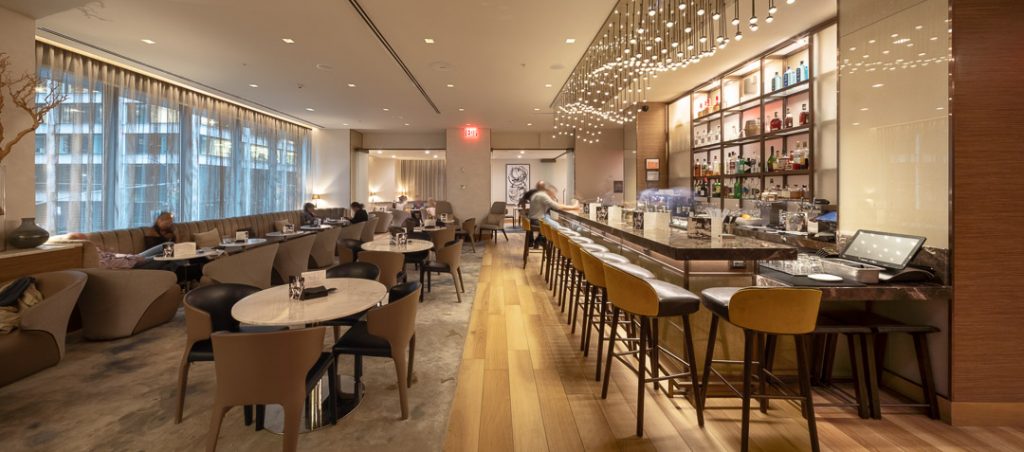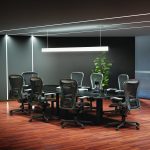Why Your Next Great Hotel Design Needs Antimicrobial Commercial Lighting
Editor’s Note: This article originally appeared in Hotel Management magazine. See the original post here.

Last summer, a headline-making housekeeping hire at the Yotel Boston wasn’t a person but a thing—a tall cleaning robot whose job was to provide a continuous line of defense against lurking, infectious threats using ultraviolet light.
The historic Beverly Hilton Hotel in Beverly Hills, Calif., made a similar splashy hire, acquiring a 3-foot-tall robot to shine UV lighting around the venue.
But each came with an under-the-radar hiccup because it used UV lighting instead of UV-free, antimicrobial commercial lighting: A protection feature shuts off the cleaning functions of both UV robots whenever movement is detected—which, in the case of a hotel, is all the time.
It’s difficult, maybe even impossible, to ensure endless sanitation with UV-lighting robots in settings where foot traffic is continual, like inside hallways, elevators, pools, lounges and lobbies, all of which often serve as around-the-clock social hubs inside hotels. UV lighting is intrinsically dangerous. Prolonged exposure at high intensities can be harmful. Potential eye problems include cataracts, issues with the cornea and temporary or permanent loss of vision. UV lighting also causes skin damage and cancer and adversely impacts physical items around a hotel.
UV lighting, despite its immediate germicidal strengths, comes with myriad limitations. UV-free, antimicrobial commercial lighting, on the other hand, does not.
It comes with no restrictions at all.
How Antimicrobial Lighting Shines a Healthful Glow
Aware of UV lighting limitations, many hotels have shifted their focus to researching and investing in newer, more innovative technologies to better safeguard their staff and guests from the rapid growth of microorganisms and the infection threats they impose.
One approach gaining fast traction is white, UV-free antimicrobial commercial LED lighting, which meets the international standard for continuous and unrestricted use with people present, courtesy of a wavelength cluster that hovers around the 405-nanometer mark, which is outside the uh-oh UV frequency range of 100 to 380 nanometers. The solution is unique in its ability to provide continuous use while protecting occupied spaces.
Antimicrobial lighting’s extermination power comes from within the visible light spectrum, between 380 and 750 nanometers. The lighting photoactivates porphyrin molecules in microbial cells. When activated, they produce excessive reactive oxygen species like singlet oxygen, hydrogen peroxide and hydroxyl groups. After an excess of reactive oxygen species builds up inside the cells, they become toxic, causing the destruction of cellular structures and ultimately leading to cell death.
Unlike microbial cells, the types of porphyrin molecules found in humans and other animals are contained in our gut and can’t be photoactivated by illumination in the 400-to-420 nanometer range.
Like other germicidal illumination, the success of UV-free, 405-nanometer commercial lighting depends on a handful of critical factors, including the amount of light reaching the surfaces in the space and the length of exposure. Nevertheless, research shows it’s quite the supplement to your manual cleaning crew’s daily efforts.
How Effective is UV-free Antimicrobial Lighting Against Bacteria and Viruses?
For more than a decade, numerous studies have proven the effectiveness of 405-nanometer visible light against many microorganisms, including bacteria, mold, fungi and yeast. In addition, research shows the technology is 90 percent or more effective against bacteria in laboratory settings and controlled-room experiments. For instance, MRSA and E. coli showed a 90 percent or greater reduction in controlled laboratory testing after just 24 hours on hard surfaces.
What’s more, visible, 405-nanometer antimicrobial light has been proven to be effective in inactivating and killing viruses. That’s according to two recent studies whose results were released in early 2021.
The first, by Microchem Laboratory in Texas, revealed that the technology was effective against nonenveloped viruses, the most challenging class of viruses to kill. Examples of nonenveloped viruses include the rhinovirus (also known as the common cold), dysentery and polio. Research shows that UV-free antimicrobial lighting on a nonenveloped virus showed a 99.985 percent reduction in a controlled laboratory setting—after just six hours on hard surfaces.
Per the Albany Business Review, a separate pre-published study by the Icahn School of Medicine at Mount Sinai in New York showed that UV-free antimicrobial lighting also inactivates enveloped viruses such as influenza, hepatitis B and C, and SARS-CoV-2, the virus that causes COVID-19.
Depending on the antimicrobial lighting system installed, there are other pluses to consider. One, for instance, is decreases in constant oversight. With antimicrobial lighting, all you need is a preset, timer or occupancy sensor. Set it, then forget it. Another is illuminating with crisp, comfortable white ambient lighting that’s free of any blue-violet hue and simultaneously disinfects. Specific antimicrobial lighting systems also have two or more continuous-cleaning methods: one mode for when guests and staff are present, the others for when they’re not.
Similarly, antimicrobial lighting does not trigger the degradation of materials as UV does. UV rays break down the chemical bonds found in plastics and causes fabric and some objects’ color to fade. How many items in your lobby, your lounge areas and in your guestrooms include rubber, plastic or fabric? Exactly.
An Enlightening Way to Improve Your Brand
Long before COVID-19 briefly capsized the hospitality industry, research showed hotel guests are willing to pay a lot more per stay for a cleaner hotel environment.
Nearly 86 percent of surveyed consumers said sanitation and cleanliness were the top two things they looked for when they read online hotel reviews, with 71 percent saying they required “above average” cleanliness from their hospitality providers to book a stay. Another study revealed that millennial guests would pay more for an overnight stay if the hotel could guarantee enhanced cleanliness.
And virtually every potential guest today reads online reviews about your hotel before booking their stay—not just on user-generated mobile review apps but on Facebook, Twitter and Instagram. What people say about your hotel brand on social media is now a better prognosticator of your success than traditional customer satisfaction metrics. All of this begs the question: What are people reading about you?
Are you providing the continuous clean sweeps that entice guests to reach deeper into their pockets? How much better would your hotel perform, and how much higher would your value climb if it enacted additional proactive cleaning measures such as UV-free antimicrobial lighting?
Prominent online ratings and money-making upticks in occupancy, revenue per available room and average daily rates await your answer.
Bill Plageman is vice president of marketing and product development at Amerlux, a wholly owned subsidiary of Delta Electronics.
Want to learn more?
To learn more about how UV-free, antimicrobial lighting differs from traditional UV lighting and where you best apply it, read: “6 Different Environments Where Clean LED Antimicrobial Technology Saved The Day.

